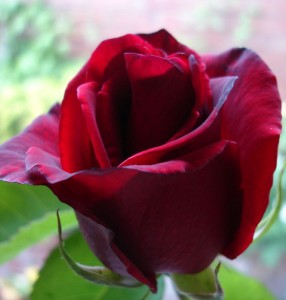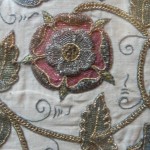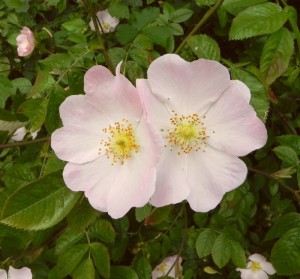 The scent of roses is in the air already this year. With whole gardens devoted to its many varieties, no flower has a closer association with summertime in England. As national flower, it also has a special link with the history of the country.
The scent of roses is in the air already this year. With whole gardens devoted to its many varieties, no flower has a closer association with summertime in England. As national flower, it also has a special link with the history of the country.
The Wars of the Roses were civil wars which raged from 1455-1485, and their continuing fame owes much to Shakespeare’s plays. Shakespeare imagined the famous scene in the Temple Garden in London, Act 2 Scene 4 of Henry VI Part 1, in which a group of arguing young noblemen pluck either red or white roses according to whether they support the house of Lancaster or York. In a theatre offering little in the way of visual resources, this scene was a brilliant stroke, together with the idea of making the supporters of each side continue to wear their roses, making it easier to follow the complicated twists and turns of the story.
The conflict ended with accession of Henry VII and his marriage, and the double rose combining the red rose of Lancaster and the white rose of York came to symbolise not just the house of Tudor which he founded but the unity of England as a whole.
The Tudor rose, symbolising unity, appeared as a decorative emblem in many different places. The two examples here show it as a carving on the front of Harvard House, Stratford, and a piece of embroidery associated with Queen Elizabeth’s favourite, Robert Dudley, Earl of Leicester.
 Roses have many symbolic meanings. For Shakespeare and for poets before and since, they have both positive associations with love, youth, beauty and sweetness and negative ones with blood, changeability and time. The combination of the rose’s beauty and its thorns symbolise the pleasures and pains of romantic and sexual love.
Roses have many symbolic meanings. For Shakespeare and for poets before and since, they have both positive associations with love, youth, beauty and sweetness and negative ones with blood, changeability and time. The combination of the rose’s beauty and its thorns symbolise the pleasures and pains of romantic and sexual love.
One of Shakespeare’s most famous lines contains a reference to a rose, spoken by his most romantic heroine, Juliet:
What’s in a name?
A rose by any other word would smell as sweet.
In A Midsummer Night’s Dream Theseus tries to persuade a young girl, Hermia that marriage (the rose distill’d) is preferable to living as a nun:
But earthlier happy is the rose distill’d
Than that which withering on the virgin thorn
Grows, lives, and dies in single blessedness.
And in Twelfth Night Orsino likens youthful beauty to a rose in bloom:
For women are as roses, whose fair flower
Being once display’d, doth fall that very hour.
Viola replies
And so they are; alas that they are so!
To die, even when they to perfection grow!
In his plays about the Wars of the Roses, as well as using roses to signify the opposing sides, Shakespeare uses roses as powerful symbols. See this blog for a discussion about the tragedy of the Battle of Towton, fought in 1461, where the horrors of civil war are made real: a father kills his son, a son his father, and there is blood on the face of a corpse:
The red rose and the white are on his face, the fatal colours of our striving houses.
John Gerarde, in his Herball, published in 1597, comments on the importance of the flower :
The rose doth deserve the chief and prime place among all floures whatsoever; being not onely esteemed for his beauty, vertues, and his fragrant and odoriferous smell; but also because it is the honor and ornament of our English Scepter, as by the conjunction appeareth, in the uniting of those two most Royall Houses of Lancaster and Yorke.
Fortunately we’re now able to enjoy the flowers solely for their beauty.




It’s interesting that this period of 15th century history is now known universally as the ‘Wars of the Roses’ and the Temple Garden scene might lead one to assume that it had always been so. In fact, the phrase was coined by Sir Walter Scott in his novel ‘Anne of Geierstein’ the early 19th century and, as almost the creator of the historical fiction genre as we think of it today, he played a pivotal role in our perception of history as story. Shakespeare, of course led the way, but in poetry rather than prose
Thanks so much for this information. I’ve never known where the phrase came from – I would never have guessed!
Lovely post Sylvia.
There’s a dramatic Edwardian mural of the imaginary scene at Westminster by Birmingham Group artist Henry Arthur Payne which is rather Pre-Raphaelite in style.
Charlecote Park has got some nice Tudor roses on the bosses of the roof of its Great Hall – they’re not Tudor though but a Victorian addition
I mean the mural is at Westminster – in Parliament -not the scene!
How interesting about the mural, how did you find out about it, and is it possible to see it?
It’s on the cover of the paperback edition of Alison Weir’s “Lancaster and York; the Wars of the Roses”, Pimlico, 1998. I don’t know if you can go and see it – I’ve emailed to find out – but you can see it online on the Art in Parliament website at http://www.parliament.uk/worksofart/artwork/henry-arthur-payne/plucking-the-red-and-white-roses-in-the-old-temple-gardens/2593.
What a great website, I had no idea. Did you also see there’s a representation of Act 1 Scene 1 of King Lear in the building – though not such a compelling image.
For anyone interested in seeing Payne’s mural, the House of Commons Information Office has sent me the following (with their permission to repeat it on this blog) – “The painting… is located in the East Corridor of the Houses of Parliament, which runs between central lobby and the lower waiting hall. This is a public area and so it would be possible to come and view the painting. I have spoken to Visitor Services and they inform me that the best way to go about this is to come in on a sitting day and gain entrance to the Palace to watch a debate. Once inside the Palace it will be possible to go and view the painting if you inform one of the Visitor Assistants of your intentions once inside. Further information regarding visiting the Houses of Parliament to watch a debate is available via the link below:
http://www.parliament.uk/visiting/attend/debates/“
How great that you followed this up. Must go for a look!